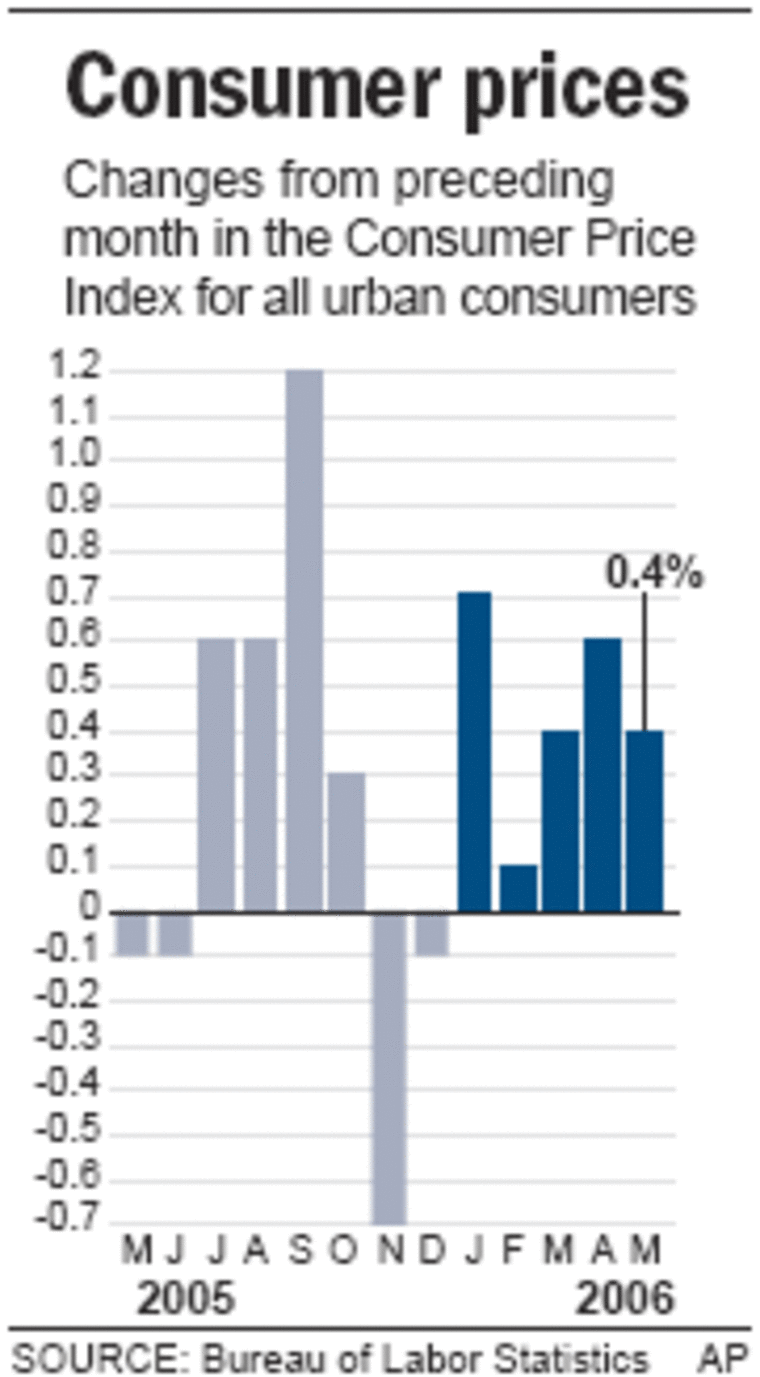Surging gasoline prices helped trigger another big increase in consumer inflation in May, and one closely watched price gauge rose at the fastest pace in 11 years.
The Labor Department reported Wednesday that its Consumer Price Index rose 0.4 percent last month, in line with expectations, while core inflation, which excludes food and energy, was up a worse-than-expected 0.3 percent.
Private economists said the latest news on inflation virtually guaranteed a 17th straight interest rate hike by the Federal Reserve at the end of this month based on recent comments by Chairman Ben Bernanke and his colleagues that they are determined to combat rising price pressures.
Wall Street, however, greeted the latest report with relief because it did not paint an even worse picture on inflation. Much of the rise in non-energy costs was blamed on a statistical quirk in how the government measures shelter costs.
The Dow Jones industrial average rose by 110.78 points to close at 10,816.92, a rebound that followed declines fueled by inflation worries in six of the past seven trading days.
Some analysts said they believed that the Fed will be able to wrap up its two-year-long credit-tightening campaign with just one or at most two more rate hikes.
“The Fed will tighten at the end the month, but that may be it for awhile,” said Mark Zandi, chief economist at Moody’s Economy.com. “Economic growth is slowing and the prospects are that it will slow even more in the months ahead.”
That view was bolstered by a separate Fed survey of nationwide business conditions which showed activity was slowing in many parts of the country with home sales and manufacturing both showing signs of cooling. The Fed is hoping for a moderate slowdown as a way to take pressure off prices.
The 0.4 percent May rise in inflation followed an even bigger 0.6 percent April increase with both months driven by soaring energy prices. Gasoline was up 4.9 percent last month following an 8.8 percent jump in April, gains that have pushed pump prices above $3 per gallon in parts of the country.
All energy prices were up 2.4 percent in May and have risen at an annual rate of 30.8 percent through May, nearly the 17.1 percent rise for all of last year.
Excluding energy and food, core inflation was up 0.3 percent. That marked the third straight 0.3 percent monthly gain and translated into an annualized increase of 3.8 percent over the past three months, the fastest pace since 1995.

Bernanke contributed to a 199-point market drop on June 5 when he called recent increases in core inflation “unwelcome developments” and signaled further rate hikes.
When he made that comment, the three-month average for core CPI inflation was a lower 3.2 percent — still well above the Fed’s comfort zone of 1 percent to 2 percent increases in core inflation.
The Fed is expected to boost its target for the federal funds rate, now at a five-year high of 5 percent, to 5.25 percent at the June 28-29 meeting. Some economists said they expected a final quarter-point move at the August meeting, allowing Bernanke, who took over from Fed legend Alan Greenspan in February, to prove his inflation-fighting mettle.
“He will be able to convince the markets that he means business in terms of price stability,” said David Jones, head of DMJ Advisors, a Denver-based economic consulting firm.
President Bush, who has seen voter unhappiness over soaring gas prices help send his approval ratings to record lows, told reporters at the White House that he had confidence the Fed would do its job to keep inflation from becoming a problem.
“Monetary policy will pay attention very carefully to the signs, inflationary signs — that’s Ben Bernanke’s job,” Bush said Wednesday.
But if inflation does not moderate, the Fed may be forced to slam even harder on the brakes, raising the risks of a more severe slowdown and possibly even a recession.
Concerns about a slowdown in the world’s largest economy have roiled financial markets around the globe in recent weeks.
The May advance in core inflation reflected a big 0.6 percent in owners’ equivalent rent, the largest jump in this category since August 1990. But analysts blamed the increase on a statistical quirk and said it was not a true measure of inflation pressures.
Overall, consumer prices through May have been rising at an annual rate of 5.2 percent, up from a 3.4 percent gain for all of 2005. Excluding food and energy, core consumer prices are up at an annual rate of 3.1 percent through May, an acceleration from a 2.2 percent rise in 2005.
In May, food prices edged up by 0.2 percent even though most of the major food categories showed declines.
Clothing prices, which had posted big increases in the past two months, slowed to a smaller 0.2 percent rise in May while new car prices fell by 0.3 percent. Airlines fares, which reflect soaring fuel costs, jumped 2.6 percent last month.